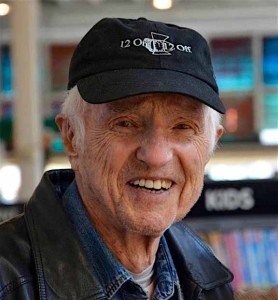![]()

The DP died peacefully in his sleep at his house in Santa Monica, according to his son Jeff Wexler. “Accepting the Academy Award in 1967, Pop said: ‘I hope we can use our art for peace and for love.’ An amazing life has ended but his lifelong commitment to fight the good fight, for peace, for all humanity, will carry on.”
“Haskell was a one-off, a wonderful man who always remained true to himself,” said award-winning cinematographer Roger Deakins. “We could all learn from that. I will miss him. We all will.”
In a career stretching over more than 60 years, Wexler’s DP credits covered an amazing range of genres. Some of the best known are America America, The Loved One, In the Heat of the Night, The Thomas Crown Affair, Days of Heaven, Coming Home, One Flew Over the Cuckoo’s Nest and American Graffiti.
Not to mention, Medium Cool, his cinema vérité style anti-establishment movie about the events surrounding the turbulent 1968 Democratic convention in Chicago. The film, which he not only photographed but also directed and wrote, remains much talked about after all these years and has become a favorite of film school students and a cult classic.
Known both for his unvarnished artistry and his lifelong political involvement in liberal causes, Wexler in 2006 was named one of the ten most influential cinematographers in the history of the craft by the International Cinematographers Guild. “He was one of the greats… and a force to be reckoned with,” said Steven Poster, president of the ICG (IA Local 600). “Haskell’s cinematography has always been an inspiration to so many of us not just at the guild but in the entire industry. His steady focus on safety over the years demonstrates his commitment to the welfare of the crew and our industry,” he added.
In 2006, Wexler made Who Needs Sleep, a documentary about the insanely long hours cinematographers and other film crew members are forced to work, and the dangers of sleep deprivation that they have to endure. He was a leader in the 12on12off movement, an evenly split-day alternative to the 15-hour shifts and longer that are all too common. In response to the outcry, IATSE at its Quadrennial Convention in 2013 passed the “Long Hours” resolution on a unanimous vote. But the IA has been unable to make much headway on the issue in labor negotiations with the big Hollywood studios which have been resistant to changes
Wexler received lifetime achievement awards from the American Society of Cinematographers, the Independent Documentary Association and the Society of Operating Cameramen. He also has a star on Hollywood Blvd., one of only six cinematographers to be celebrated on “The Walk of Fame.”
Born in Chicago in 1922, he first learned cinematography working at a Midwest movie studio his father built. After briefly attending the University of California at Berkeley, he joined the Merchant Marine during World War II. Afterwards Wexler began working on industrial films, commercials and documentaries. He joined the ICG in 1947.
In 1953 he co-directed and shot a documentary short The Living City, which was nominated for an Oscar. He got to Hollywood where he got his first break, along with so many others, on Roger Corman movies, starting with Stakeout on Dope Street in 1957. He also was an assistant cameraman on The Adventures of Ozzie and Harriet.
Wexler started working on higher quality films, with a breakthrough coming for his attention-getting black-and-white cinematography on America America directed by Elia Kazan. In the next few years he worked on The Best Man, about a political convention, directed by Franklin Schaeffer and The Loved One, a biting satire on Southern California cemeteries, directed by Tony Richardson.
In 1966 he reached his first career peak as DP on Who’s Afraid of Virginia Woolf, starring Elizabeth Taylor and Richard Burton, and directed by Mike Nichols. Wexler won his first Oscar for his unadorned, no-holds-barred B&W camerawork on the film adaptation of the gripping Edward Albee play. It was the last year separate Academy Awards were handed out for best B&W and best color cinematography. Ten years later Wexler got another Oscar for Bound for Glory, directed by Hal Ashby, about the early career of folk singer Woody Guthrie. He also received nominations for One Flew Over the Cuckoo’s Nest, directed by Milos Forman; Matewan, directed by John Sayles; and Ron Shelton’s Blaze.
Other directors Wexler worked with over the years include Francis Ford Coppola, Terrence Malick and George Lucas.
Wexler also did many politically charged documentaries. Interview with My Lai Veterans brought him a shared Oscar in 1970 for best documentary short. He worked frequently with Saul Landau on subjects still controversial and in the case of Quest for Power: Sketches of the American New Right, made in 1982, that are front and center in today’s political arena. He also shot Brazil: A Report on Torture, An Interview with President Allende, The Swine Flu Caper, The CIA Case Officer and Target Nicaragua: Inside a Secret War.
Wexler felt there was one blot on his career: He shot the famous Marlboro man commercial, but he later came out against the tobacco companies and joined non-smoking campaigns.





